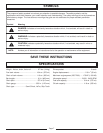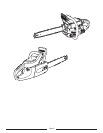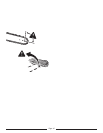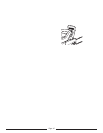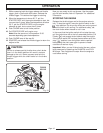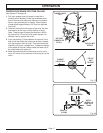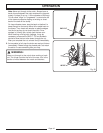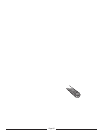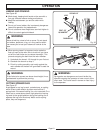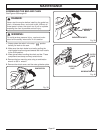
Page 15
BASIC OPERATING/CUTTING PROCEDURES
Practice cutting a few small logs using the following
technique to get the “feel” of using your saw before you
begin a major sawing operation.
1. Take the proper stance in front of the wood with the saw
idling.
2. Accelerate the engine to full throttle just before entering
the cut by squeezing the throttle trigger.
3. Begin cutting with the saw against the log.
4. Keep the engine at full throttle the entire time you are
cutting.
5. Allow the chain to cut for you; exert only light downward
pressure. Forcing the cut could result in damage to the
bar, chain, or engine.
6. Release the throttle trigger as soon as the cut is com-
pleted allowing the engine to idle. Running the saw at
full throttle without a cutting load can result in unneces-
sary wear to the chain, bar, and engine.
7. Do not put pressure on the saw at the end of the cut.
WORK AREA PRECAUTIONS
See Figure 23.
Cut only wood or materials made from wood; no sheet
metal, no plastics, no masonry, no non-wood building
materials.
Never allow children to operate your saw. Allow no
person to use this chain saw who has not read this
operator's manual or received adequate instructions for
the safe and proper use of this chain saw.
Keep everyone – helpers, bystanders, children, and
animals, a SAFE DISTANCE from the cutting area.
During felling operations, the safe distance should be a
least twice the height of the largest trees in the felling
area. During bucking operations, keep a minimum
distance of 15 feet (4.5m) between workers.
The carburetor is factory set and should not require
adjusting. The carburetor will permit only limited adjust-
ment of the “L” (Low Jet) and “H” (High Jet) needles. Any
adjustment should be done by a Homelite Service Center.
Under no circumstances should the “L” (Low Jet) and “H”
(High Jet) needles be forced outside the range of adjust-
ment.
CAUTION:
Serious damage can occur to the engine if improper
adjustments are made to the “L” and “H” needles.
Do not force the “L” and “H” needles outside the
adjustment range!
AIR FILTER
STARTER COVER
VENTS
Always cut with both feet on solid ground to prevent
being pulled off balance.
Do not cut above chest height as a saw held higher is
difficult to control against kickback forces.
Fig. 25
Fig. 23
Fig. 24
OPERATION
Do not fell trees near electrical wires or buildings.
Leave this operation for professionals.
Cut only when visibility and light are adequate for you
to see clearly.
ADJUSTING THE CARBURETOR
See Figures 24 and 25.
Before adjusting the carburetor, clean the air filter and the
starter cover vents. Allow the engine to warm up prior to
carburetor adjustment. Refer to “Maintenance” later in this
manual.



